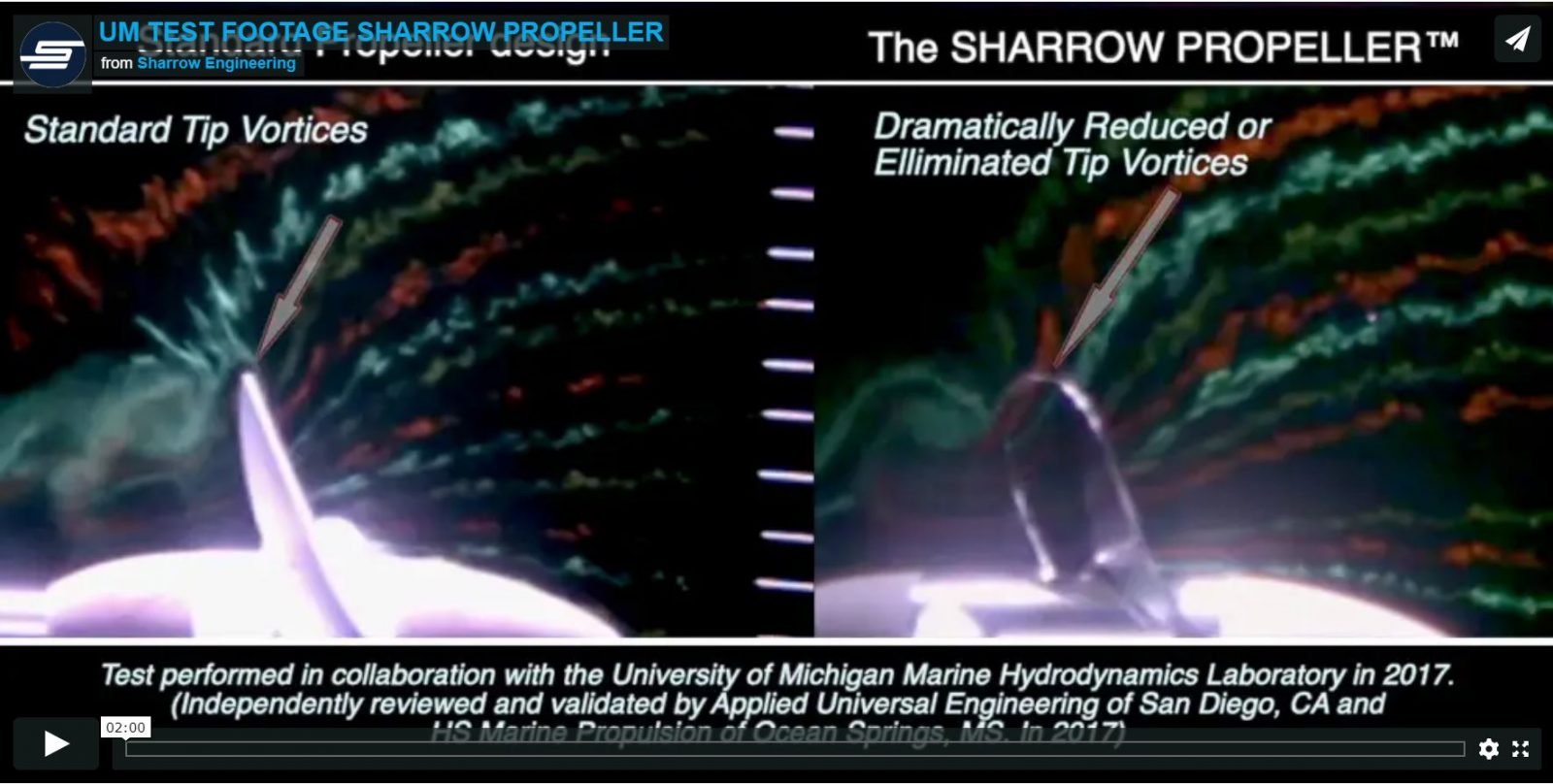MIBS2020: Sharrow MX-1
Note: I’m going to do a series of short entries on some of the interesting products I saw at the Miami International Boat Show (MIBS). This year I co-chaired the innovation awards which gave me the opportunity to see many of these products and talk with the companies.
The Sharrow propeller design is quite different than anything I’ve seen before and has the potential to revolutionize propellers. Sharrow says — and BoatTest’s independent review agrees — that their MX-1 propeller can increase efficiency by up to 15 percent. But they also say the prop will increase top speed, reduce vibration, improve handling, and plane at lower speeds.

According to Greg Sharrow, the founder of Sharrow Marine, the main key to all these improvements is avoiding tip vortices. Tip vortices are circular disturbances in the water at the tip of a traditional propeller. Sharrow’s design eliminates tips and with that vastly reduces the disturbances in the water that sap efficiency and cause noise and vibration. Sharrow’s design has the potential to replace nearly any conventional shaped propeller from small recreational boats to 1,000 foot ships and early testing has confirmed similar or greater efficiency on these large ships.

The MX-1 received the Innovation Award at the Miami International Boat Show for propulsion equipment and parts. Given the potential impact of the MX-1 this one seemed especially easy. It’s quite inspiring to see a rethinking of a design that’s been around for hundreds of years.















I’m impressed by the Sharrow prop design from what I’ve seen so far and there may be another feature I haven’t see mentioned: I suspect that wrapping lobster pot lines and similar in this prop won’t happen as easily as with the familiar designs.
Put me far over in the skeptic camp on this one. While the conventional three or four blade prop is found on virtually all recreational and smaller commercial vessels, an enormous amount has gone into R&D over many decades to design better props for naval ships and large commercial vessels. I would think that virtually everything has been tried, especially nowadays with the availability of sophisticated computer modeling. What it comes down to is that the low volume production runs and expensive fabrication have kept the innovations from those other markets from appearing in the recreational market. The owners will pay an awful lot for a 2% more efficient prop on a big container ship that burns tons of bunker per day hundreds of days per year. A 100 hour small boat recreational user can only justify a very small premium.
So Mr Sharrow may be really good at marketing but his main innovation is trying to bring some of the well know techniques of big ship prop design to the recreational market.
Quitsa,
I appreciate and respect your skepticism but I’m curious to learn a little more about your skepticism. Have you seen a similar design in larger commercial applications? I haven’t but can’t claim to track all the developments in the commercial and defense space.
Sharrow says they’ve done work on much larger ships and seen similar results. I don’t have the ability to verify their claims but they have impressed quite a few folks. I’m hoping to have the opportunity to get out and experience some of this for myself.
Ben
I used to be the portfolio manager of a large private equity fund. We bought a number of large container and bulk carrier ships after the 2008 crisis. In the process, I ended up learning quite a bit about the operation of such vessels. There is an array of high efficiency propeller designs that have come into wide use. with all sorts of shapes and blade counts., nozzles, pods, multiple props, etc etc. It is possible that Sharrow has come up with something that was not explored but as I said in my post, that just seems implausible considering the amount of effort than has gone into efficient propeller design since the big jump in oil prices way back in 1973. And then there is the US Navy, which has been researching propeller design since the switch from sail.
The tests that Sharrow made available are not especially convincing nor do they appear to have been sufficiently controlled to ensure that the prop was the only variable affecting performance.
Everything has been already tried.! Reallya, what a load of hogwash.
I have seen a trial on video comparing the Sharrow to a conventional prop. It was quite impressive. However I think it is more fair to compare Sharrow to a duo prop installation. Especially considering the cost if Sharrow props. I am not sure the Sharrow would be superior in such a test…
Would a duo Sharrow prop installation be the best of “two worlds”, or just a crazy idea?!
Mattias
“We shall see said the zen master.”
More third party tests and real life experience will show if this indeed is something revolutionary. Interesting, in any case.
Any indication on the pricing?
How do I order a sharrow prop.
Alexandro
Alexandro, Sharrow is selling their MX outboard props at their own site, but they are $5,000 each, take 3 months to create, and first there has to be a conversation with Sharrow about your exact engine and boat situation:
https://www.sharrowmarine.com/store
Sharrow has also announced a deal with Yamaha Marine Precision Propellers whereby YMPP will manufacture their prop design and sell them via the vast Yamaha outboard distribution and boatbuilder network:
https://www.businesswire.com/news/home/20220621005308/en/Sharrow-Marine-Yamaha-Marine-Precision-Propellers-Announce-Global-Distribution-and-Manufacturing-Supply-Agreement
Finally, the highly detailed (though commissioned) BoatTest.com testing seems to indicate that the Sharrow design really works better than conventional props, even on inboards and diesel outboards with separate exhaust ports:
https://boattest.com/Sharrow-Propeller